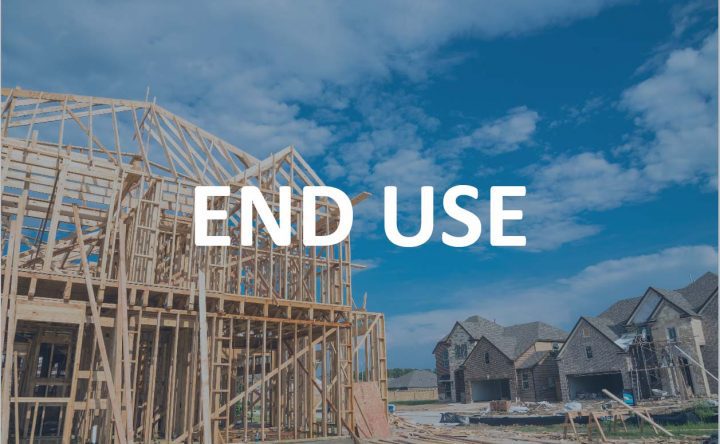The U.S. Department of Labor is reporting that an additional 260,000 Americans made their initial filing for unemployment benefits during the week ending on Saturday, January 22, 2022. This is a decrease of 30,000 from the previous week’s revised level. The 4-week moving average was 247,000 — an increase of 15,000 from the previous week’s revised average.
News in end use
Federal Funds Rate Remains Unchanged… For the Time Being
The Federal Open Market Committee (FOMC) ended its two-day meeting on Wednesday (1-26-22) and announced that it had decided not to raise the Fed Funds Rate for the time being. The FOMC cited solid job gains and a decline in the unemployment rated as the reason for keeping the target range for the federal funds rate at 0 to 1/4 percent. “The Committee expects it will soon be appropriate to raise the target range for the federal funds rate…”
December New Home Sales Up Month-Over-Month but Down Year-Over-Year
On Wednesday (1-26-22), The U.S. Census Bureau and Department of Housing and Urban Development jointly announced that new residential single-family home sales for December 2021 were at a SAAR of 811,000, according to estimates. This is 11.9% above the revised November rate of 725,000 but is -14.0% below the December 2020 estimate of 943,000. The seasonally adjusted estimates of new houses for sales at the end of December was 403,000.
Mortgage Applications Decrease in Week Ending January 21, 2022
According to data from the Mortgage Bankers Association’s (MBA) Weekly Mortgage Application Survey (WMAS), for the week ending January 21, 2022, the Market Composite Index, a measure of mortgage loan application volume, declined -7.1% on a seasonally adjusted basis from one week earlier. On an unadjusted basis, the Index decreased -6.0% compared with the previous week. The Refinance Index decreased -13.0% from the previous week and was -53.0% lower than the same week one year ago.
Federal Housing Finance Agency Reports U.S. Home Prices Increase 1.1% Month-Over-Month and 17.5% Year-Over-Year in November 2021
According to the latest Federal Housing Finance Agency (FHFA) House Price Index (HPI®), released today (1-25-22), U.S. house prices increased 1.1% month-over-month in November. House prices increased 17.5% from November 2020 to November 2021. The previously reported 1.1% percent price change for October 2021 remained unchanged.
Home Prices Increase 1.5% Month-Over-Month and 21.0% Year-Over-Year in November, According to First American Financial Corporation
In November’s RHPI, First American found that real house prices increased by 1.5% from October and were up 21.0% year-over-year. It also found that the average house now costs $475,180 up $2,818 from $472,362 in October, while the average household income is $69,807, up by $414 from $69,393. According to First American, the three key points of the First American RHPI are income, mortgage rates, and an unadjusted house price index.
S&P CoreLogic Case-Shiller National Home Price Index Increases 18.8% in November
According to the S&P CoreLogic Case-Shiller U.S. National Home Price NSA Index, which covers all nine U.S. Census divisions, reported today (1-25-22) that home prices experienced a 18.8% annual gain in November. This is down from a 19.0% annual gain in October, which was down from the 19.7% annual gain in September 2021. The 10-City Composite annual increase came in at 16.8%, down from 17.2% in October.
Consumer Confidence Declines in January, Ending Three Consecutive Months of Gains
The Conference Board, a non-partisan, not-for-profit think tank founded in 1916, released today (1-25-22) their Consumer Confidence Index® (CCI) for January 2022. The CCI declined in January after an increase in December. The Index now stands at 113.8 (1985=100), down from 115.2 in December. The Present Situation Index — based on consumers’ assessment of current business and labor market conditions — improved to 148.2 from 144.8 in December.
Freddie Mac Predicts Stable Single-Family Housing Market in 2022
Freddie Mac released its new Quarterly Forecast on Friday (1-21-22). The forecast is from Freddie Mac’s Chief Economist Sam Khater, who is predicting that in spite of mortgage interest rates rising, the single-family housing market in 2022 will remain stable. Khater added that rising rates will lead to moderation in homebuyer demand, slowing house price growth somewhat.
Americans Continue to Place Homeownership on Hold
According to the National Association of Home Builders’ Q4 2021 Housing Trends Report (HTR), the share of U.S. adults planning a home purchase within the next 12 months has fallen for the second consecutive quarter. The share fell from 17% in Q2, to 16% in Q3, to 15% in Q4. The HTR sees more Americans postponing their homeownership plans due to higher home prices and low housing availability — relative to demand.



